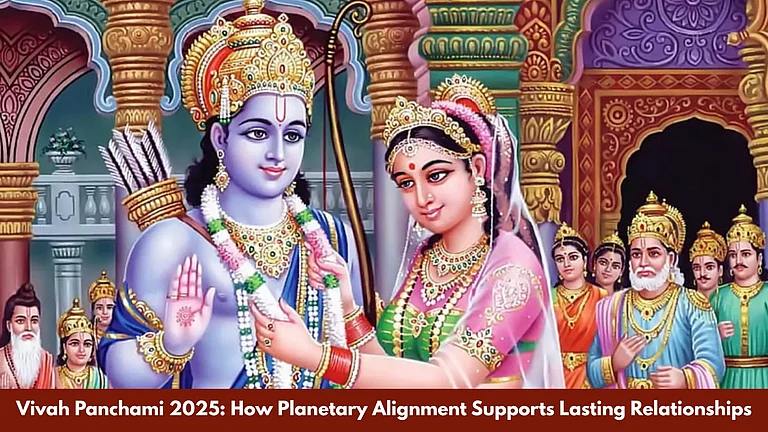Tulsi Vivah, the divine marriage of Goddess Tulsi (Vrinda) and Lord Vishnu, is one of the most sacred Hindu rituals symbolising purity, devotion, and cosmic balance. Celebrated on the Dwadashī of the Shukla Paksha in Kartik month, it marks the end of Chaturmas and the beginning of the auspicious wedding season. In 2025, Tulsi Vivah falls on Sunday, November 2. This celestial union not only restores universal harmony but also brings prosperity, marital bliss, and positive energy to households, making it a spiritually significant day for devotees across India.
Tulsi Vivah 2025 — Date & Muhurat:
In 2025, Tulsi Vivah falls on Sunday, 2 November 2025, on the Dwadashī (twelfth day) of the Shukla Paksha in the Kartik month. The tithi begins at about 07:31 AM on 2 Nov and ends at 05:07 AM on 3 Nov in many regions.
Brahma Muhurta from 4:50 AM to 5:42 AM
Abhijit Muhurta from 11:42 AM to 12:26 PM
Vijay Muhurta from 1:55 PM to 2:39 PM
The Karmic Tale Behind Tulsi Vivah:
The legend of Tulsi Vivah is rich with devotion, curse, transformation and divine union:
The goddess Tulsi (also called Vrinda) was married to the demon‐king Jalandhara. Her unwavering chastity and devotion made Jalandhara invincible.
The gods sought a solution, and Lord Vishnu intervened; in one version, he deceives Vrinda while disguised, leading to the breaking of her vow and Jalandhara’s downfall. Vrinda curses Vishnu, and then transforms into the Tulsi plant, and Vishnu promises to wed her in her next existence.
Thus, the ceremonial marriage of the Tulsi plant (symbolising Vrinda) with Shaligrama or Vishnu represents the fulfilment of that promise. It is a karmic resolution of vows, purity, and devotion.
This myth underpins why the festival is more than a ceremony—it is about fidelity, transformation, and the link between divine and human.
Why Tulsi Vivah Marks the End of Chaturmas:
The period of Chaturmas (monsoon months) is traditionally inauspicious for many auspicious ceremonies, weddings, etc. The ritual of Tulsi Vivah symbolises:
The end of the monsoon, the return of auspiciousness, and the opening of the wedding season.
It marks the shift from a period of retreat/purification (Chaturmas) to one of social celebration and ritual marriage. Thus, after Tulsi Vivah, households may begin more festive rituals, marriages and social ceremonies.
The union of Tulsi & Vishnu also symbolises nature’s recovery (Tulsi plant) and divine presence (Vishnu), restoring cosmic balance after the monsoon’s dormancy.
Tulsi Vivah Rituals for Removing Relationship Doshas:
For those seeking to remove obstacles in relationships or marriages (doshas such as delay in marriage, strife, etc.), Tulsi Vivah offers a potent ceremonial remedy. Here are the ritual steps and key pointers:
Preparations:
Choose a healthy Tulsi plant at home or temple, clean the area, and decorate with flowers and lights.
Place a Shaligrama stone or Vishnu’s picture/idol as the groom.
Ensure sanctity and purity: bathe, wear clean clothes, light a diya.
Ritual Steps:
Invoke Lord Ganesha to remove obstacles.
Offer haldi (turmeric) and kumkum to Tulsi, apply them to the Shaligrama/Vishnu.
Perform the wedding ceremony: exchange garlands (var‐mala) between Tulsi and Vishnu/Shaligrama. Tie a red chunri around the plant and the idol, symbolising bridal dress and union.
Offer fruits, sweets, rice, ghee, flowers and foliage to both Tulsi and Vishnu.
Pray sincerely for the removal of obstacles: for a timely marriage, a harmonious relationship, and stability. Tulsi is considered an incarnation of Lakshmi and a remedy for relationship and household prosperity.
Conclude with a short aarti and distribute prasad to family and friends.
Why this works (astrologically & symbolically):
The ceremonial marriage is itself a “kanyadaan” (giving away of the bride) — one of the highest religious acts — so participating or witnessing it is believed to remove doshas relating to marriage delay or mismatch.
The Tulsi plant is sacred, tied to Venus‐Laksmi energy (marital harmony, prosperity); Vishnu is the protector. Their union symbolises harmony between active (male) and receptive (female) cosmic forces, thereby stabilising relationship energies.
Since the festival occurs just as an auspicious period begins (post‐Chaturmas), any ritual done on this day acquires added potency for relationships, home peace, and prosperity.
Tips to strengthen the effect:
Do the puja during the muhurat or as close to it as possible.
Maintain devotion and purity: avoid quarrels, keep the atmosphere positive.
If marriage is delayed or there is strife: light a lamp near the Tulsi plant every day up to Kartik Purnima, offer prayers for the groom for Tulsi and your relationship.
Share the prasad with family and neighbours, symbolising social harmony which reflects personal harmony.
Tulsi Vivah 2025 isn’t just a ritual; it is a divine union that restores cosmic as well as personal balance. On 2 November 2025, you have the opportunity to engage with this sacred ceremony. It symbolises devotion turned into a relationship, nature embraced by divinity, and the end of cocooned time (Chaturmas), ushering in new beginnings. When performed with sincerity, its rituals become powerful aids to remove relationship blocks, invite marital harmony, and infuse home life with the paired blessings of Tulsi (Lakshmi) and Vishnu (protection).





























